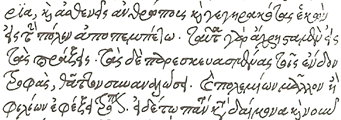Angelos Bergekios

 This is about two different 'kai's'. In the Lord's Prayer here 'kai', meaning 'and', is written in two completely different ways. The first one I have decided to call 'shorthand kappa with varia', for want of finding a name that someone else has given it, (see yesterday's post ). The second one is better-known and comes with its own codepoint in Unicode. It is called 'U+03D7 : GREEK KAI SYMBOL'. This is because it is used today in Greece, so I understand.
This is about two different 'kai's'. In the Lord's Prayer here 'kai', meaning 'and', is written in two completely different ways. The first one I have decided to call 'shorthand kappa with varia', for want of finding a name that someone else has given it, (see yesterday's post ). The second one is better-known and comes with its own codepoint in Unicode. It is called 'U+03D7 : GREEK KAI SYMBOL'. This is because it is used today in Greece, so I understand.If the first one can be analysed as 'shorthand kappa with varia,' then the second one can be dissected as 'kappa with shorthand alpha-iota.' (Sometimes these are called ligatures but they do not derive from the two original letters, they were established as shorthand. See my bibliography at the bottom of this post for further details on Greek shorthand.)
In any case, the question is, how did these two forms of 'kai' turn up in print in 1713? Fortunately the library has fac-similes of Greek manuscripts. I have found a copy of a manuscript by Angelos Bergekios (Angelus Vergecius).
Apparently Bergekios "used his own writing as a model in designing the 'grecs du roi' types cut by Garamond for Robert Estienne in 1542, the ancestor of nearly all Greek types for more than two centuries." Barbour. xxiv
 This excerpt from Bergekios' manuscript illustrates the use of both 'kai's'. Other similar details are the way that 'rho' and 'mu' are tied by a ligature to the following vowel. In the first line, fourth word, ανθρωποις, has a rho-omega ligature and the sixth word, γεγηρακατοις, the rho-alpha ligature. In the Lord's Prayer, linked to above, at the end of the first line, ουρανοις has a rho-alpha ligature.
This excerpt from Bergekios' manuscript illustrates the use of both 'kai's'. Other similar details are the way that 'rho' and 'mu' are tied by a ligature to the following vowel. In the first line, fourth word, ανθρωποις, has a rho-omega ligature and the sixth word, γεγηρακατοις, the rho-alpha ligature. In the Lord's Prayer, linked to above, at the end of the first line, ουρανοις has a rho-alpha ligature.
So, was the type for the Lord's Prayer in Oratio Dominica designed by Bergekios? I don't know for sure, but it was in the same tradition or style. It was an era in which people were using type to imitate manuscripts. I should also note that the types were designed in 1542 and this manuscript was written in 1564. This should not be too surprising since manuscript copying continued to coexist with printing for over a century.
Here is Pete
 r Daniels' take on this, "There was no photolithography in those days, so the only way to publish a faithful reproduction of a manuscript was to cut hundreds of sorts imitating the ligatures. (Cf. the Gutenberg Bible.)" That sounds very labour-intensive! Here is a copy of the full page text of Bergekios' manuscript from Omont. 1974. Click to enlarge. Here the scribe is called Ange Vergèce since the book is in French.
r Daniels' take on this, "There was no photolithography in those days, so the only way to publish a faithful reproduction of a manuscript was to cut hundreds of sorts imitating the ligatures. (Cf. the Gutenberg Bible.)" That sounds very labour-intensive! Here is a copy of the full page text of Bergekios' manuscript from Omont. 1974. Click to enlarge. Here the scribe is called Ange Vergèce since the book is in French.Barbour, Ruth. Greek Literary Hands. A.D. 400-1600. 1981. Clarendon Press. Oxford.
Lehmann, Oskar. Die Tachygraphischen Abkurzungen Der Griechischen Handschriften. 1965. Georg Holms. Hildesheim
Omont, H. A. Fac-Similés de Manuscrits Grecs des XVe et XVIe Siècles. 1974. Georg Holms. Hildesheim.
Addendum:
Thanks to Eli I have found Ricoblog. In this post he has an image of a page of Erasmus' edition of the New Testament. Sure enough, in line 8 and 10 both the 'shorthand kappa with varia' glyph and the word 'kai' are represented. These are both written with an ampersand in Latin.

0 Comments:
Post a Comment
<< Home